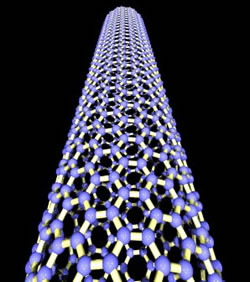Scientists have developed miniature artificial muscles capable of working at extreme temperatures. Writing in the current edition of the journal Science, University of Texas at Dallas researcher Ray Baughman and his team have produced layers of carbon nanotubes that can contract in milliseconds when an electric field is applied, becoming shorter and fatter in the process.
Incredibly, the tubes, which are thousands of times thinner than a human hair yet have the tensile strength of steel, can perform this feat at any temperature from as low as -200 to as high as nearly +2000 degrees celsius. And unlike the average human muscle, which shortens by about 20% when it contracts, these nanomuscles shorten by more than 200% when current is applied.
 Bizarrely the material is also stretchier than rubber in directions other than the one in which it shrinks. The team made the new material by first using a technique called vapour deposition to grow clusters of the nanotubes resembling a bamboo forest. These clusters were then teased apart using adhesive surfaces to produce the tiny sheets. How might they be used?
Bizarrely the material is also stretchier than rubber in directions other than the one in which it shrinks. The team made the new material by first using a technique called vapour deposition to grow clusters of the nanotubes resembling a bamboo forest. These clusters were then teased apart using adhesive surfaces to produce the tiny sheets. How might they be used?
The team suggest that, in addition to extending the capabilities of artificial muscles to giant "strokes" and at extreme temperatures, the movement capabilities of the sheets could also allow them to be used to produce superior solar cells and LEDS by manipulating a surface into the ideal optical position and then locking it in place. "This is very exciting," says Baughman.
- Previous It’s Alive – Artificial DNA
- Next UV to C to TB










Comments
Add a comment